New clues are emerging about the mysterious streaks that appear on Mars' surface during warm weather, though scientists still can't say for sure that they're caused by flowing water.
The marks, known as recurring slope lineae (RSL), snake down some crater walls and other inclines when the mercury rises on the Red Planet. New research finds seasonal changes in iron minerals at RSL sites, suggesting that brines containing an iron antifreeze may flow there from time to time — but direct evidence of water remains elusive.
"We still don't have a smoking gun for existence of water in RSL, although we're not sure how this process would take place without water," Lujendra Ojha, a graduate student at Georgia Tech in Atlanta, lead author of two recent RSL studies, said in a statement. (Ojha discovered the RSL in 2011, while an undergraduate at the University of Arizona.) [ Photos: The Search for Water on Mars ]
Ojha and his colleagues studied images of 13 RSL sites taken by the Compact Reconnaissance Imaging Spectrometer for Mars (CRISM), an instrument aboard NASA's Mars Reconnaissance Orbiter (MRO). They saw relatively high concentrations of iron minerals at most of the sites.
"Just like the RSL themselves, the strength of the spectral signatures varies according to the seasons," Ojha said. "They're stronger when it's warmer and less significant when it's colder."
Many scientists think the recurring slope lineae are created by water flowing just beneath the Martian surface. This water — which would leave the iron antifreezes and other minerals in its wake — likely contains salts that lower its freezing point significantly, allowing it to stay liquid despite frigid Red Planet temperatures.
While the researchers didn't see any spectral signatures of water in the CRISM images, that doesn't rule out the substance's presence at RSL sites, scientists said.
"The flow of water, even briny water, anywhere on Mars today would be a major discovery, impacting our understanding of present climate change on Mars and possibly indicating potential habitats for life near the surface on modern Mars," MRO project scientist Richard Zurek, of NASA's Jet Propulsion Laboratory in Pasadena, Calif., said in a statement.
— Mike Wall, Space.com.
Follow Mike Wall on Twitter @michaeldwall and Google+. Follow @Spacedotcomon Twitter,Facebook or Google+. Read the full story on Space.com.
